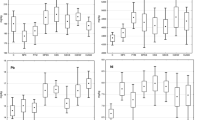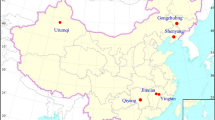Abstract
Goal, Scope and Background
Andisols are widespread in Japan and have some special properties such as high anion exchange capacity, low bulk density, and high organic matter content, which might influence the accumulation or chemical fractionation of heavy metals. However, few such data exist in Japanese andisols. The primary objective of this study was to investigate the distribution and chemical fractions of Cu, Zn, Ni, and Cr in the soil profiles and subsequently to assess their potential environmental hazard.
Materials and Methods
Soil samples were taken from a field experiment conducted on Japanese andisols, which had received either swine compost or chemical fertilizers for 6 years. Concentrations of Cu, Zn, Ni, and Cr were determined for all of the obtained extract solutions by ICP-AES.
Results and Discussion
Considerably higher total concentrations of Cu and Zn were observed in the top 20 cm layer of the compost-amended soil, relative to the unfertilized soil, while chemical fertilizers had little effect. Application of the swine compost increased the concentrations of Cu and Zn, but not Ni and Cr, in all fractions in the top 20 cm layer. The greatest increase in the organically bound fraction (OM) Cu and dilute acid-exchangeable fraction (DAEXCH) Zn was observed. This suggests that Cu and Zn are potentially bioavailable and mobile in the andisol profiles after 6-year consecutive applications of the swine compost. On the other hand, distribution of Cu, Zn, Ni and Cr among various soil fractions was generally unaffected by chemical fertilizers.
Conclusions
We observed that 6-year consecutive applications of the swine compost led to an increase in total metals of Cu and Zn, as well as their all-chemical fractions, in the top 20 cm soil layers. Potential hazard of heavy metals, especially of Cu and Zn, as a result of the use of swine compost on andisols, must be taken into account.
Recommendations and Outlook
The long-term effect of the accumulation of heavy metals, particularly Cu and Zn, in various plant tissues and soils, as well as their potential risk to surface water via runoff and groundwater via leaching, needs to be carefully considered. Further investigations in the long-term experiments are therefore necessary.
-
Abbreviations. EXCH, exchangeable fraction of metals; DAEXCH, dilute acid-exchangeable fraction of metals; FeMnOX, iron and manganese-oxide-bound fraction; OM, organically-bound fraction; RESD, residual fraction. COMPOST, SRNF, RANF, and CONTROL stand for compost (from swine wastes), slow-release nitrogen fertilizer (coated urea), readily available nitrogen fertilizer (including NH4-N, P, and K fertilizers), and no fertilizer application, respectively.
Similar content being viewed by others
Author information
Authors and Affiliations
Corresponding authors
Rights and permissions
About this article
Cite this article
ZHAO, B., Maeda, M., Zhang, J. et al. Accumulation and Chemical Fractionation of Heavy Metals in Andisols after a Different, 6-year Fertilization Management (8 pp). Env Sci Poll Res Int 13, 90–97 (2006). https://doi.org/10.1065/espr2005.06.268
Received:
Accepted:
Published:
Issue Date:
DOI: https://doi.org/10.1065/espr2005.06.268




